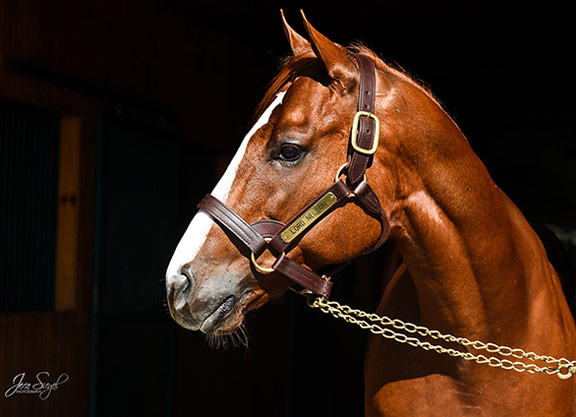By Bill Finley
In the days leading up to the 2016 GI Breeders' Cup Sprint, the connections of Lord Nelson (Pulpit–African Jade, by Seeking the Gold), B. Wayne Hughes's Spendthrift Farm and Bob Baffert, couldn't have imagined being in a better spot. Their horse was the 5-2 morning-line favorite in the race and had reeled off three straight Grade I wins. Win or lose in the Sprint, the next stage was what figured to be a promising stud career at Spendthrift Farm.
Then everything unraveled. The then 4-year-old developed an infection in his right foreleg and that led to him being scratched from the Sprint. Worse yet, the infection turned into laminitis and there was more than one point where the Spendthrift team did not think the promising stallion would survive. The chestnut missed the entire 2017 breeding season.
But, not only has Lord Nelson survived, he has recovered to the point where Spendthrift plans to breed him in 2018, believing he can cover somewhere in the neighborhood of 80 mares. His stud fee is $25,000.
“It's a pretty remarkable story,” said Spendthrift General Manager Ned Toffey. “I've been doing this a long time now and the developments they've made in the treatment of laminitis have been extraordinary. We've gotten so much better at treating this. It's still something where you spend a lot of time feeling helpless. We got to the point where we thought there was a very real possibility we were going to lose him. It is very remarkable that he's gotten himself back to this point.”
Though disappointed that Lord Nelson could not compete in the Breeders' Cup Sprint, Toffey believed the injury would heal well before the start of the 2017 breeding season. Instead, there were complications in January that led to the laminitis which put everything on hold and the horse's life in jeopardy.
“He had rotation in both front coffin bones and he had very little sole depth, particularly in his right front foot,” Toffey said. “We got to the point where we had to cut the deep digital flexor tendon, which relieves pressure on the coffin bone. That's a procedure you do when you've run out of options. We did that and there was no instant change. It was more a long, slow process, but he gradually improved to the point where he is today. He looks great, is turned out in a paddock and is being shown to breeders.”
Toffey said credit for the recovery goes to the vets at Rood and Riddle, the vets at Spendthrift and the stallion manager and his crew. But, he said the real hero in all this is Lord Nelson himself.
“Maybe the most remarkable individual in all of this is Lord Nelson himself, the horse,” said the native of Great Barrington, Mass. “All the medications and treatments he had thrown at him, a lot of horses couldn't have handled that. Often those treatments can cause a whole different set of problems. If he were a human being he could drink anybody under the table. He's made of iron.”
Spendthrift will proceed cautiously once breeding season begins. He could likely be bred to more than 80 mares, but Toffey said the farm does not want to put too much stress on the horse. They will also make sure he is not bred more than twice a day. If Lord Nelson holds up to the rigors of breeding beyond what the expectations are, Spendthrift has the option of increasing the number of mares in his book because they have plenty of their own they can mate him with.
“We want to give him a nice book of mares without stressing him and we want to give him the chance to get off to the right kind of start as a sire,” Toffey said.
Lord Nelson was seven for 13 during his career with five stakes wins and $958,271 in earnings. The 5-year-old closed out his racing career with consecutive wins in the GI Triple Bend S., the GI Bing Crosby S and the GI Santa Anita Sprint Championship. He also won the GII San Vicente S. in 2015.
Click here to listen to Ned Toffey and Dr. James Morehead talk about Lord Nelson's recovery from laminitis.
Not a subscriber? Click here to sign up for the daily PDF or alerts.






